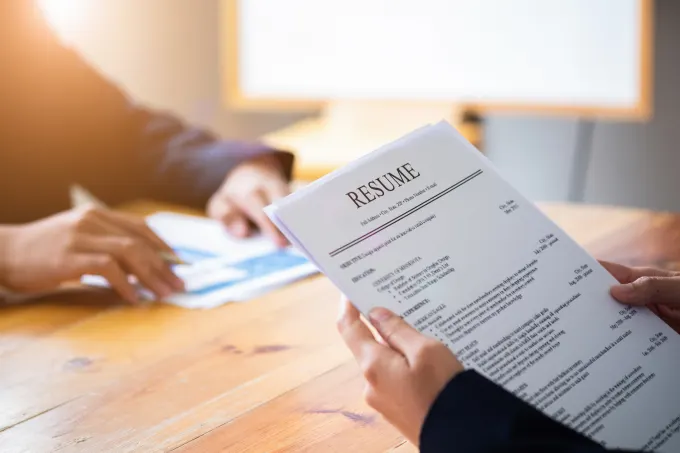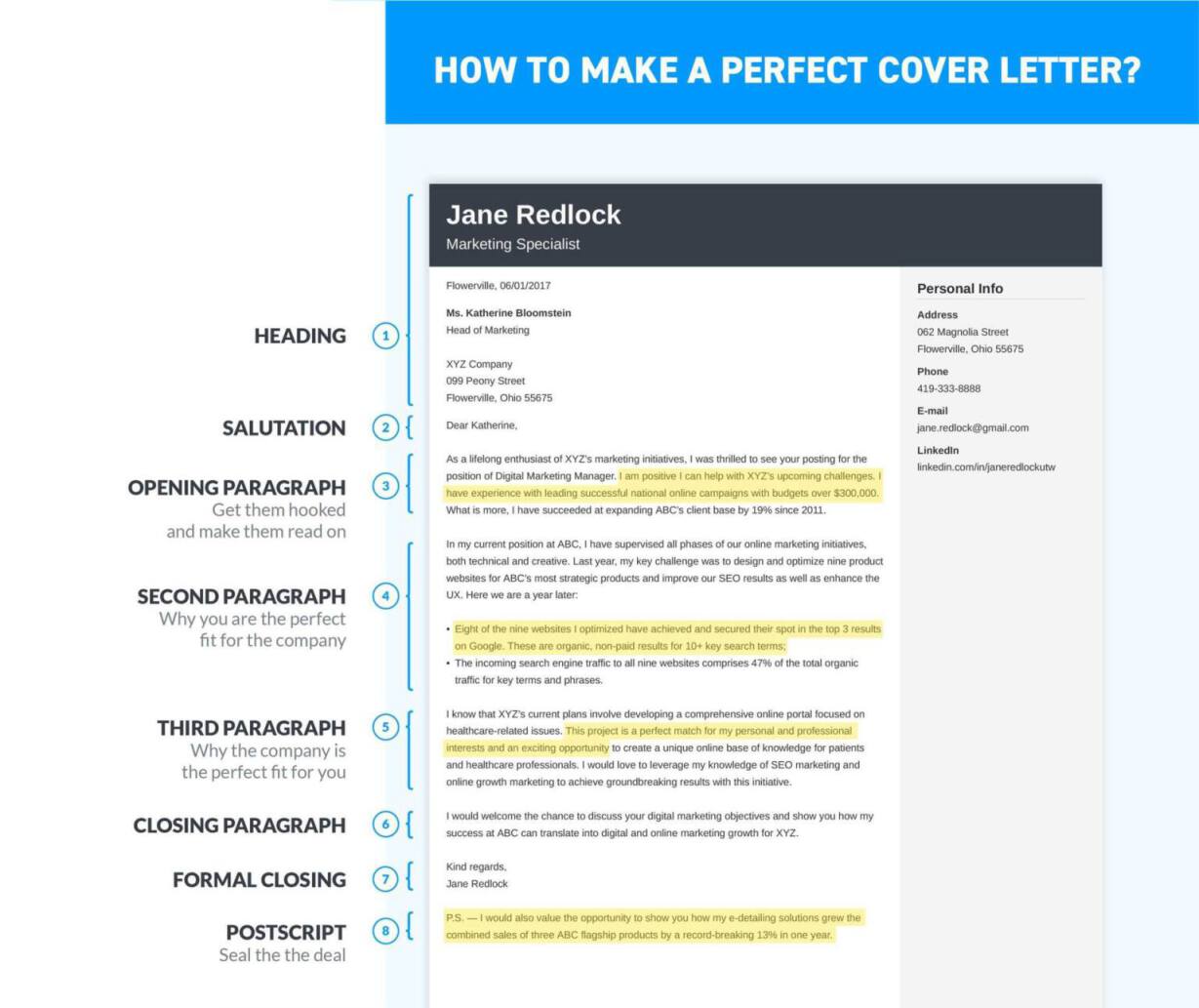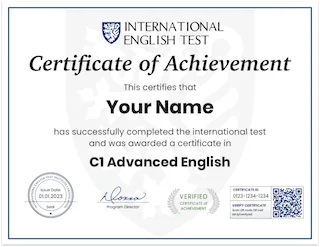A cover letter serves as your exclusive chance to display your personality and expertise, going beyond that by illustrating why you are the perfect fit for the job. The ability to write a cover letter skillfully can profoundly impact the trajectory of your career.
This all-encompassing guide aims to unravel the intricacies of cover letter writing. It offers valuable insights and practical tips, empowering you to create an exceptional document with confidence and finesse.
What is your English level?
Find out your A1 A2 B1 B2 C1 C2 level of English with our quick, free online test.
What Is a Cover Letter?
A cover letter is a concise, one-page document submitted alongside your resume or CV as part of a job application. Its purpose is twofold: to present a more personalized introduction of yourself and to offer a broader context for your qualifications and accomplishments. A well-crafted cover letter can effectively showcase your value to the hiring manager.
While this guide primarily focuses on writing a cover letter for job applications, it’s worth noting that you can also compose an application letter if you’re not yet in the job market. For instance, drafting a cover letter for a scholarship application can enhance your chances of securing financial aid. Similarly, an internship cover letter can draw attention to your skills, mitigating concerns about your limited work experience.
How to Write a Cover Letter
Crafting a cover letter often proves to be a challenging task for many jobseekers. However, let me assist you through the process, and you’ll find that it’s not as daunting as it may seem!
To summarize how to create an effective cover letter: Utilize a business letter format and a professional template. Provide contact information for both yourself and the employer, and address the hiring manager by name. In a concise 200–400 words, emphasize your accomplishments, professional skills, and pertinent experience that position you as the ideal candidate for the job.
1. Get ready in advance
You might be eager to start immediately, but hold on for a moment! Before diving into writing your cover letter, it’s essential to know what content to include, isn’t it? Take some time to gather information beforehand.
Here are a few things to research before writing a cover letter:
- Job prerequisites: Ensure a clear understanding of them as your letter will make reference to these.
- Company website: At a minimum, review the company’s website. Explore its history, objectives, and strive to understand its organizational culture.
- Hiring manager: Make an effort to discover and address the hiring manager by name in your letter.
- Your resume: Confirm that your resume distinctly demonstrates your suitability for the position, and keep it readily accessible for quick reference.

2.Adhere to the correct format for your cover letter.
The cover letter format doesn’t leave much room for creativity. Attempting to compose poetry when applying for a corporate job might not be the most advisable approach. Nevertheless, there is flexibility in selecting a template, as long as it incorporates the essential components of a cover letter. All of these key elements are illustrated in the image below:

Opting for a pre-existing cover letter template can be a time-saving choice. There’s an extensive range of styles and designs available, encompassing modern cover letter templates and those tailored for creative professions. Alternatively, you have the flexibility to create a template from the ground up using Word or Google Docs. The decision is entirely yours.
Here’s how to format your cover letter:
-
Select a readable cover letter font such as Arial or Garamond, maintaining a font size between 10 and 12 points.
-
Ensure even margins on all sides, ideally set at 1 inch.
-
Left-align all content in your cover letter.
-
Employ double spacing between paragraphs and maintain a spacing of 1–1.15 between lines.
-
Title your cover letter as JobTitle—CoverLetter—YourName.
-
Preserve the layout of your cover letter by saving the file in PDF format when submitting it to the recruiter.
-
Condense all relevant information onto a single page, as that is the recommended length for a cover letter.
Are you C1 Advanced English?
Get your C1 Advanced English certificate now!
✓ Add your certificate to your resume
⭐ ⭐ ⭐ ⭐ ⭐
3. Create a Cover Letter Header
A formal cover letter begins with a header. It’s recommended that your cover letter header matches that of your resume for consistency, so feel free to utilize the same template.
If you opt to create the header for your cover letter manually, include the following contact details:
- Full name
- Job title
- Phone number
- Email address
4. Address the Reader
After completing the header, proceed to indicate the location and date of composition.
Afterwards, direct your cover letter specifically to the hiring manager, such as:
- Dear Katherine,
- Dear Ms. jhon,
- Dear Mr. McConnor,
Follow this template to make sure you include everything:
[Location, MM/DD/YYYY]
[Hiring Manager’s or Recruiter’s Name]
[Hiring Manager’s or Recruiter’s Job Title]
[Company Name]
[Company Address]
Dear [Ms./Mr.] …
5. Make a Proper Introduction
Here’s the straightforward reality: the initial sentences of your cover letter will decide whether the hiring manager continues reading. Therefore, you must craft the introduction of your cover letter in a manner that captivates and retains the reader’s interest.
Here are a few established approaches for initiating your cover letter:
- Highlight your achievements.
- Display your passion and enthusiasm.
- Drop names.
- Do all the above.

6. Explain Why You’re the Perfect Fit
It seems like your message got cut off. Could you please provide more details or clarify your request? I’m here to help!
- Give the hiring manager what they’re looking for.
- Show that you’ll satisfy the company’s specific needs.
7. Show Your Motivation to Join the Company
Your prospective employers have specific requirements. If they are considering hiring you, it’s because they believe you can meet those requirements. Additionally, they desire a positive working relationship with you, as it increases the likelihood of your long-term commitment to the organization.
Crafting an ideal third paragraph for your cover letter involves demonstrating to the hiring manager why you are specifically interested in this particular job, not just any job. This is particularly crucial for entry-level candidates, as showcasing enthusiasm and passion helps establish that you are ready to make a significant impact from the start.
What is your English level?
Find out your A1 A2 B1 B2 C1 C2 level of English with our quick, free online test.
8. Close With a Promise
It seems like your message got cut off again. Could you please provide more information or clarify your request? I’m here to assist you!
The most detrimental errors to avoid in composing the concluding paragraph of your cover letter includ
- Projecting an impression of desperation
- Emphasizing your desire for the job rather than highlighting your qualifications
- Reiterating the overused phrase, “Thank you for your consideration and your time”
Rather than that, express to the hiring manager your anticipation for an in-person meeting where you can discuss how your expertise and insights can contribute to achieving your prospective employer’s objectives.
9. Stay Formal in the Closing Salutation
It appears that your message is truncated or incomplete. Could you please provide more details or clarify your request so I can better assist you?
If you’re not a fan of the well-worn “Sincerely,” feel free to use any of the following:
- Respectfully yours,
- With best regards,
- Thank you,
- Best regards,
- Kind regards,

10. Add a Postscript
Each of the aforementioned sections is essential in a well-crafted cover letter. However, there’s a special technique you can employ—the postscript. Its significance lies in its ability to act like a magnet for the hiring manager’s attention, compelling them not to overlook crucial information.
Include a postscript in your cover letter to inform the hiring manager about an impressive aspect of your career, even if it’s not directly related to the job opening. Express your willingness to provide additional details if they find it intriguing.
Creating a Cover Letter That Sets You Apart
Consider your cover letter as a personal billboard, providing an opportunity to showcase what sets you apart. It’s not a mere repetition of your resume but a complement to it, enriched with your unique narrative.
Commence with a captivating opening that immediately grabs your reader’s attention. Highlight your significant accomplishments, ensuring they are connected to the company’s needs, as this is a mutual consideration.
Maintain conciseness, infuse a personal touch, and foster a positive tone. Demonstrate not only why you’re an excellent fit for the job but also a seamless addition to their team. With the right approach, your cover letter will not only be noticeable but truly stand out!
Why Do You Need a Cover Letter?
An effective cover letter enhances your resume by demonstrating to the employer that your qualifications align with their requirements, affirming your suitability for the position.
Plus, a well-written cover letter:
- Demonstrates thorough research and a dedicated approach to the job.
- Affirms your comprehension of the company’s challenges.
- Indicates alignment of your vision with their goals.
- Illustrates how your skills and experience provide a viable solution.
In essence, an effective cover letter should center around “why should we hire you” and “what’s in it for us.” The key strategy is to prioritize the employer’s perspective, not just your own, thereby distinguishing yourself from other applicants.
Inspiring Examples of Professional Cover Letters
If you encounter difficulties while composing your cover letter, referring to a professional cover letter example can provide valuable assistance. Below are 10 excellent sample cover letters for job applications:
- Versatile Cover Letter: easily adaptable for any desired job
- Transitioning Career Cover Letter: ideal for those changing professions
- Management Cover Letter: customizable for various managerial roles
- Student Cover Letter: highlights academic achievements and skills
- Educator Cover Letter: aims to impress the school administration
- IT Cover Letter: showcases more than just coding skills
- Government Job Cover Letter: for those aiming for a position in the public sector
- Academic Position Cover Letter: tailored for academic roles
- Entry-Level Cover Letter: addresses the common challenge of limited experience
- Internal Position Cover Letter: suitable for those seeking a move within the same company
Explore our assortment of professional cover letter samples by visiting our collection here.
Moreover, having a compelling cover letter that complements your resume provides a competitive edge over other candidates. You can easily create one using our cover letter builder available here. Here’s a preview of what it could resemble:

Key Takeaway
Here is a recap of the 10 steps to crafting an outstanding cover letter:
1. Conduct thorough research on the company and the job.
2. Format the cover letter template in compliance with industry standards.
3. Confirm the accuracy of your contact information in the header.
4. Address the hiring manager or recruiter by name.
5. Capture their attention with a compelling introduction.
6. Leverage your experience to demonstrate a precise alignment with the company’s requirements.
7. Elaborate on your motivation and suitability for the position.
8. Conclude with a call to action, expressing the desire for a meeting.
9. Maintain formality in the closing sentiment.
10. Consider including a postscript for added impact.
Alternatively, employ our cover letter builder to effortlessly handle all these steps for you!
What is your English level?
Find out your A1 A2 B1 B2 C1 C2 level of English with our quick, free online test.





